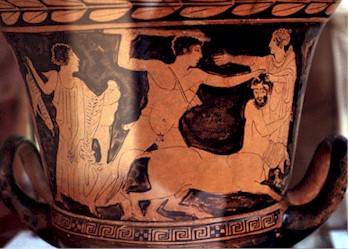Lovers of Herakles
![]()
Herakles
had what seems like innumerable lovers. His
reputation as a hunky lover probably stems from the many myths about these
escapades, including his sleeping with fifty girls in one night.
Here is a brief overview of some of the more significant mythological
women that he has been involved with.
Auge
Herakles
is described as seducing Auge, a priestess of Athena. She bore Telephus (Pausanias
8.4.9; Apoll. 2.7.4). This is
interesting because Athena helps Herakles so often, yet he seduces her priestess.
(Athena was a virgin goddess.) This
shows his personality as a casual lover.
Daughters of Thespius
There
are various versions of this tale, but the main theme is that Herakles is asked
by the King Thespius to sleep with his daughters because he was anxious for
them to have children by Herakles. Apollodorus
says that at the age of 18, and during the Cithaeronian lion hunt, Herakles
slept with 50 girls in 50 nights. (This averages out to about seven minutes each.)
He also states that Herakles thought that he was sleeping with the same
girl every night. Pausansias,
however, writes that Herakles slept with all of the daughters in one night,
except for one that refused. She was consequently condemned to be a virgin as she was made
a priestess in his shrine at Thespiae (Diodorus
Siculus: iv.29, Apollodorus: ii.4.10 and ii.7.8; Pausanias ix. 27. 5-7).
|
Deianeira Deianeira was Herakles' second wife. She ultimately kills him after taking the advice of the centaur Nessus that Herakles had rescued her from and killed earlier. See Heracles as Husband for more.
|

Herakles rescuing Deianeira from the centaur Nessus |
Hebe
Hebe
is the daughter of Zeus and of Hera. She
is regarded as the gods cup bearer and her responsibilities included pouring and
bringing wine to the gods. She is
worshipped as the goddess of pardons or forgiveness.
Most primary sources describe Herakles marrying Hebe after he dies and
ascends to Olympus. Apollodorus
states that they had two sons together, Alexiares and Anicetus (book 2 7.7).
There is some disagreement as to whether this marriage ends the
bitterness between him and Hera, or whether because her resentment had ended,
that she allowed this marriage to take place.
This black
figure dinos, c. 580 BC, portrays their marriage.
Megara
Megara
is the daughter of Creon, the king of Thebes.
She was the first wife of Herakles.
Some myths describe him killing her in a fit of rage brought on by Hera
(Euripides, Herakles). In
other versions, Herakles gives her in marriage to Iolaus (Apollodorus 2.6.1).
Her name means a place where they threw meat during a ritual.
It is associated with death, ghosts, the underworld (Harison, 1957, pp.
38, 122-123). She is an aspect of
the Earth – Mother; a duplicate of Hera.
Scythia
Scythia
is a half woman, half serpent creature that Herakles slept with so that she
would return his mares to him. This
shows the malevolent mother may be benign if her libido is satisfied. (Herodotus
iv. 8-10; cf. Fontenrose 1959:97-98).
Xenodice
During
Herakles servitude to Omphale, he became involved with Xenodice. According to
Apollodorus, Herakles ultimately kills Xenodice and her father’, because her
father was forcing people to work in his vinyard.
This adds to his reputation as a woman slayer.
(Apollodorus 2.6.3)
Further
Information
The
Greek Mythology Link shows a detailed
list of all Herakles' lovers and offspring.